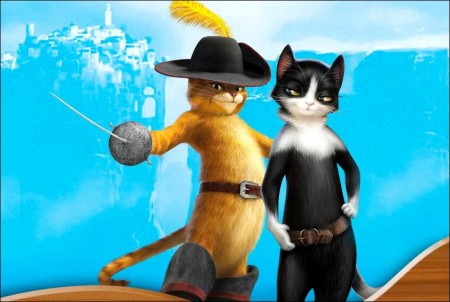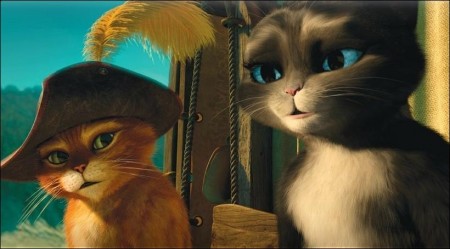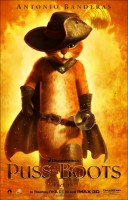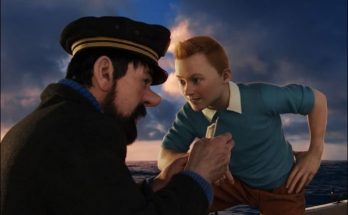Taglines: Looking good never looked so good.
Puss in Boots is a computer-animated adventure film being produced by DreamWorks Animation, directed by Chris Miller (who directed Shrek the Third in 2007), executive produced by Guillermo del Toro, starring Antonio Banderas, Billy Bob Thornton and Salma Hayek, and written by Tom Wheeler. It is set to be released in theaters on October 28, 2011 in Digital 3D and IMAX 3D.
The film is a spinoff prequel to the Shrek series and it follows the character Puss in Boots on his adventures before his first appearance in Shrek 2 in 2004. Accompanied by his sidekicks, Humpty Dumpty and Kitty Softpaws, Puss is pitted against Jack and Jill, two murderous outlaws who discover an ancient power which threatens the world.
Long before he even met Shrek, the notorious fighter, lover and outlaw Puss in Boots becomes a hero when he sets off on an adventure with the tough and street smart Kitty Softpaws and the mastermind Humpty Dumpty to save his town. Complicating matters along the way are the notorious outlaws Jack and Jill, who will do anything to see that Puss and his band do not succeed. This is the true story of The Cat, The Myth, The Legend…and, of course, The Boots.
A Legendary Tail Tale to Tell
Chris Miller is a born multi-tasker. Animator, story artist, performer, filmmaker—a graduate of the prestigious California Institute of the Arts/Film and Animation department, Miller commanded a successful career in commercial, video and film work before landing at the then-young DreamWorks Animation Studio SKG as a story artist on the studio’s first animated comedy hit, “Antz.”
After that, he became a ground-floor member of an elite group that would change animation history: as a story artist on the Academy Award®-winning film, “Shrek,” head of story on the hit follow-up “Shrek 2” and director of “Shrek the Third” (not to mention voicing several memorable characters along the way, such as beloved penguin Kowalski in the Madagascar films and Magic Mirror in Shrek) Chris found himself an integral part of the most successful animated film series of all time.
It was while head of story on “Shrek 2” that Miller first ‘met’ the unforgettable feline known as Puss in Boots. Even then, he could tell the cat was destined for great things. Miller remembers, “Puss in Boots was such an important part of the success of Shrek 2, I felt it was only a matter of time before he broke out on to his own. He’s such an appealing character, and it was clear that this guy needed his own tale told. I just gravitated towards that cat—this little package came with such a history behind him, you knew that there were endless stories and adventures. I always wanted to know, ‘Okay, what’s your deal? Where’d you get the accent? More importantly, where did you get the awesome boots? How did it all come together?’”
Miller saw a multitude of characteristics that made the adventuresome feline irresistible: “There’s a bit of the devil in him, which is what I really like about him, but he’s still got this tremendous heart. Despite his size, he’s this huge figure.”
Emmy-winning producer Joe M. Aguilar is also a DreamWorks Animation veteran, having served as a senior executive and key producer at the Company since its inception. Producer Aguilar sums up the appeal of Puss, “Out of all the characters you could call supporting, he’s the character most people are very interested in knowing more about. In developing a feature about Puss in Boots, we went after something worthy of his character…something filled with comedy and adventure, something that really took advantage of how charismatic he is.”
Producer Latifa Ouaou was also there at the character’s beginning, serving as Story/Editorial Supervisor on “Shrek 2.” She shares her own reason why audiences embraced the swashbuckler: “What makes Puss in Boots so special is that inside this tiny, little cat is this huge personality with a deep voice. He’s got so much ego, pride and bravado, and yet, you can distract him with a can of tuna or a spot of reflected light. I think that makes for an extremely loveable and comedic figure.”
Chris Miller felt so strongly about the character that he wanted to helm Puss’s feature film debut: “I wanted to direct ‘Puss in Boots’ because I just felt that this character deserved his own origin story—although small in stature, he is larger-than-life. He’s deserving of a really epically funny tale. I just wanted to be there when we delved into his world, something that really represented all of the facets of his character: he’s little, but bold, dramatic, romantic. I think all that makes him perfect for a big movie.”
Such an idea had been a priority around the studio since the Tabby held his hat in his paws and gave audiences ‘big sad kitty eyes.’ According to producer Ouaou, “The movie really came together when Chris Miller came onboard to direct the project—he’s been involved in all of the ‘Shrek’ cinetime and directed the third one, and he came from being a Storyboard Artist. He’s a great storyteller who uniquely understood this character. Outside of his storytelling abilities, he’s also just got a great visual sense. But on top of that, he’s really about characters with depth, and the comedy really coming from these characters. I think that’s what makes him really special.”
The director describes the film as, “A story about brotherhood that goes awry and turns sour, and ultimately it’s about revenge and redemption…but at its core, it’s a comedy. Puss is very funny. When we first meet Puss, he’s an outlaw on the run, a fugitive from justice, racing from town to town—but we also know he’s in search of a way to clear his name and right his past.”
In telling the well known story of Puss, filmmakers looked beyond his fairy tale origin to find their own bracing adventure of how this cat came into legend. As with other self-created stories at DreamWorks Animation, an outline was created, with a talented group establishing the rhythm of the story beats—director, producers, head of story, writers and other development experts. Head of Story Bob Persichetti recalls, “The first movie I worked on at the studio was ‘Shrek 2,’ and the first sequence I worked on was the one that introduced Puss in Boots, so I’ve been involved with him, well, since the beginning, around 2001. And I feel that everyone knew, immediately, what a great character he was. He should have his own feature. “
Persichetti states what may be obvious to anyone looking at the credits of the “Puss in Boots” team: “For most of us, it’s like working with a family. In one way or another, we’ve all been with the character since he appeared. Chris’ sensibilities and sense of humor are perfect for this story. And he’s an incredibly collaborative artist, so heading up some 400 people—more than 600 at our busiest—seems totally right for him. He’s great with pulling everything together and bringing out the strengths of everyone.”
Putting “Puss in Boots” in His Place…
It’s clearly obvious that the world of moviegoers loves Shrek and his cohorts. But when it came time to setting the origin story of Puss in Boots, filmmakers intended no offense by looking elsewhere than the woods and countrysides of Far Far Away. Joe Aguilar explains, “When we first started ‘Puss in Boots,’ we realized that we couldn’t deviate too far from the Shrek world, because that is the universe in which he exists. To completely redesign that world would just throw the audiences off. But, we knew we could go pretty far, while remaining in that universe. We pushed, as far as we could, the design and the caricature of our secondary characters—it has a different look and feel than the Shrek franchise, but we definitely stayed within the universe.”
Miller offers more specifics: “It’s a sort of southern European Mediterranean fairy tale world that Puss lives in. It’s very warm, bright and colorful. A lot of these decisions just came from the character. The Shrek world is very cool, with lush greens and blues—‘Puss in Boots’ world is very warm, hot, romanticized. I think of it as a different part of the fairy tale/nursery rhyme universe.”
Producer Ouaou affirms, “I think, though, we really wanted to play with legends. We found influences in the old Sergio Leone films, and looked to more Spanish-based architecture. But we were conscious of not veering too far from where he was introduced. You can only go so far—too much, and he’s no longer recognizable in his environment. We wanted to update the Puss in Boots fairy tale—we didn’t necessarily feel like we needed to connect it to the original story.”
A bandit’s share of the responsibility for designing Puss’ world fell to production designer Guillaume Aretos, who served as Art Director on the second and third “Shrek” films.
Aretos asserts, “I was with that franchise for a long time, and that team is kind of my family now. Puss in Boots is a pretty exciting character to bring to the screen, because I think he’s pretty special. “What excited me about the film was a chance to do something different—we took him into a pushed, stylized world, where we got to play with big, symbolic shadows, in this very colorful world.”
The director was adamant that the world they created support this gem of a character. Their shared goal was a place that lent itself to grand, sweeping cinema, full of active camera work and bold composition. As Puss is, by anyone’s view, a ‘colorful’ character, the landscape also had to offer and support a full palette of rich, warm, saturated colors. Above all, this was to be a place of action, adventure, comedy and romance, because, “this world should just be a reflection of who Puss is, at his core.”
The director worked with the artists to create a world with a familiar vernacular of style. “We really wanted to approach this like an old spaghetti Western of Leone, which we felt suited the character perfectly, in terms of size and scope. We adopted that expansive use of the camera, and even used some split screen. But we also didn’t want to limit ourselves just to that—I’d say that that is definitely in the fabric of our film—because while Puss is suited to those types of films, he also lends himself to other genres that feature a strong, adventurous lead, say, Indiana Jones, 007, Zorro. There are others, too. So in the end, we started looking at the history of film, gathering inspiration from those larger-than-life characters.”
Production designer Aretos: “If you look at the design, the inspiration for it, as a whole, is very simple—it’s the character himself. He’s a twisted character—I mean that in a literal sense. In terms of shape language, we started twisting the shape of things. If you look at the sets, you can see that all of the houses are kind of tilted. Nothing is really straight. We have asymmetry, with very unbalanced characters—going from small to gigantic. So that all goes to the shape language. The other thing is that Puss is a very colorful character. We gathered inspiration from Latin culture, and looked at some Spanish cinetime. We went for a less realistic lighting; we went more free, more crazy. We got to play with big shadows, because Puss is a small character in a very big world. In the Shrek cinetime, Puss was about three-feet high, when standing in his boots, to balance always being with Shrek, a seven-foot giant. We realized that, in this world, that size wouldn’t work—we’re in a human world without giants, so we put him back to a normal cat size…if cats wore boots and stood upright.”
A saying of Aretos early in production became a guiding design principle: Crooked characters, crooked world. He illustrates, “We looked at the geography in the north of Spain, which is dry, but beautiful, and noticed that the olive and pine trees along the coast were bent by the winds. We also looked at other desert climates in North and Central America. This imbalance is in our characters and their surroundings.”
One of the more specific sites that drew the filmmakers’ eyes was the town of San Miguel de Allende, in central Mexico, with its sienna-colored neo-classical colonial buildings.
In the world of animation, one of the biggest differences between it and its live-action counterpart is in the use of an editor. Unlike live-action, where the editor customarily assembles the film toward the end of principal photography, an animation editor is involved from the beginning, up front, working during the story process, to help establish beats, rhythm, story arcs and other aspects that are the results of an artfully assembled collection of images.
Eric Dapkewicz is editor on “Puss in Boots,” and he began his ‘homework’ by watching such classics as “The Good, the Bad and the Ugly” and “A Fistful of Dollars,” along with other films that feature sweeping narrative and heroic leads. The end result was a unique style unafraid to feature an homage to the genre that reinvigorated the American Western—some scenes hold on a character, taking in the environment, perhaps a tad bit longer than what is expected in animation. An integral part of such an evocation of Leone is scoring, from composer Henry Jackman, whose work has been featured in everything from Hollywood action blockbusters to gentle romantic comedies. Like Dapkewicz, Jackman boarded the project in the first phases, and supplied music to aid in establishing the flow and feel of the movie (beginning with temporary tracks, eventually refining to final score).
It is this strong team effort from the get-go that Miller feels is the key to building a successful project. He enthuses, “The contributions from every department on this movie have been extraordinary. Guillaume and the art department contributed so much beauty, drama and color and were integral to the story we were telling. Our head of story, Bob Persichetti, and the entire team brought so many great ideas to the table. Head of layout, Gil Zimmerman, who shot the film, and his department, just translated vision into reality. I’ve been so fortunate, working with Joe and Latifa, these incredible filmmakers—all the chemistry was right and made for a wonderful collaboration and a really satisfying experience.”
Another noteworthy member of the “Puss in Boots” production team is award-winning filmmaker Guillermo del Toro, who serendipitously was visiting the DreamWorks Animation campus early in production, which allowed for Chris Miller to spend some face time. The director recounts, “Guillermo really gravitated towards this story, he loved the tone of the pitch. And as it turned out, the very next day, we were screening the movie, and he was able to come. He loved it, and told me afterwards that he wanted to be a part of the movie. And I was thrilled and almost speechless, and said something like, ‘Great, when can you start?’ And he said, ‘Right now.’ So within this 24-hour period, he became an executive producer and a great consultant on the movie. He has this wonderful energy, and he always approaches challenges with a solution—he doesn’t criticize, he’s someone who can look at something and offer ideas on how to make things better.”
One such solve was in the history of the character of Humpty—as a largely misunderstood dreamer in the orphanage, his backstory was fleshed out when del Toro offered the suggestion that perhaps Dumpty invented things as a youth. This would help establish the character’s smarts and pay off in story developments down the line. The filmmaker was so enthusiastic about participating in the project that he even voiced the character of the Comandante of the village of San Ricardo.
Producer Aguilar: “Guillermo del Toro is just one of the most inspiring people to work with. He’s full of energy, fun ideas and a lot of artistic design knowledge. He’s just like a library of cinema.” The Academy Award®-nominated del Toro says: “When we were starting the movie, I volunteered to do a ‘celebratory scream’ in the party, and that led to my playing the part of the Comandante, sort of a father figure to Puss. We thought of him as a Mexican Clint Eastwood, very low, very solemn. In the beginning it was just a scratch voice, but everyone liked it, so, they kept it. “I think people will be surprised by the singular level of artistry the movie has,” Del Toro continues. “It’s a huge movie with huge action sequences, broad adventure, great comedy, a rich, colorful fantasy, full of imagination, full of inventiveness. I think it is a complete banquet in and of itself. It’s not just a spinoff, it is its own absolute world.”
Puss in Boots
Directed by: Chris Miller
Starring: Antonio Banderas, Billy Bob Thornton, Amy Sedaris, Salma Hayek, Walt Dohrn, Zach Galifianakis, Constance Marie
Screenplay by: Charles Perrault, Brian Lynch
Production Design by: Guillaume Aretos
Film Editing by: Eric Dapkewicz
Art Direction by: Christian Schellewald
Music by: Henry Jackman
MPAA Rating: PG for some adventure action and mild rude humor.
Studio: DreamWorks Pictures
Release Date: November 4, 2011
Hits: 144





